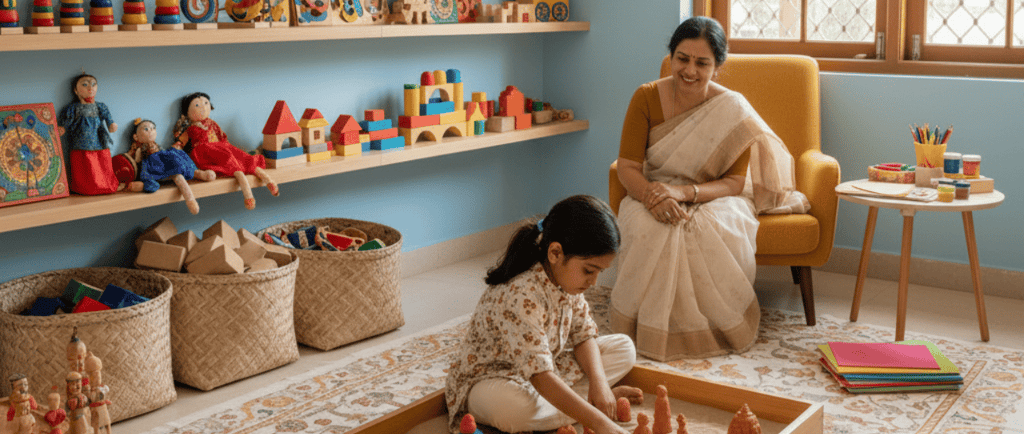Play Therapy for Kids: Techniques and Benefits
Understand the Importance of Play for Children
OCCUPATIONAL THERAPYSENSORY INTEGRATIONPLAY THERAPY
Dr. Dipak Kumar
10/5/20256 min read


When words aren’t enough, play becomes the language children use to express themselves. For many kids—especially those dealing with anxiety, trauma, ADHD, autism, or behavioral challenges—play therapy opens a safe and magical space where healing and growth happen naturally.
Through toys, stories, art, and games, children learn to communicate feelings they might not yet understand or have the words to express. It’s not “just play”—it’s a powerful, research-backed approach used by trained therapists to help kids navigate life’s toughest emotions and experiences.
🌈
What Is Play Therapy?
Play therapy is a form of psychotherapy specially designed for children, based on the understanding that play is a child’s natural language and toys are their words.
Developed in the early 20th century and refined by pioneers like Virginia Axline (the creator of non-directive play therapy), this approach recognizes that children often cannot articulate complex emotions the way adults can. Through play, they can act out experiences, experiment with solutions, and express their inner world safely.
In a play therapy session, a trained play therapist creates a warm, accepting environment filled with toys, art supplies, puppets, sand trays, and games. The therapist observes, interacts, or guides play (depending on the approach), helping the child:
Express emotions freely
Learn coping strategies
Develop problem-solving and social skills
Heal from trauma or loss
Build self-esteem and confidence
The sessions typically last about 30–50 minutes, once or twice a week. The process is gentle, respectful, and deeply child-centered—never forced.
Why Play Therapy Works
For adults, talking helps us process emotions. For children, playing does the same thing.
Think of it this way: when a child plays “doctor,” “family,” or “superhero,” they aren’t just pretending—they’re experimenting with real-life roles, fears, and hopes. Play allows children to:
Recreate events they don’t fully understand
Regain a sense of control over scary or confusing experiences
Practice coping skills in a safe, symbolic way
Release bottled-up emotions (anger, fear, sadness) through movement, storytelling, or art
From a neuroscience perspective, play helps organize brain connections, especially in the areas responsible for emotional regulation, problem-solving, and empathy.
Research from the Association for Play Therapy (APT) and numerous studies show that play therapy can significantly reduce symptoms of anxiety, depression, trauma, aggression, and attention difficulties.
The Role of the Play Therapist
Play therapy isn’t just free play—it’s guided, intentional, and informed by training.
A certified play therapist has a background in psychology, counseling, or occupational therapy, and specialized training in child development and therapeutic play techniques.
Their role is to:
Create a safe, accepting space where the child feels seen and heard.
Observe patterns in how the child uses toys, characters, or art.
Reflect emotions and themes through gentle conversation or symbolic interpretation.
Introduce activities that support self-expression and emotional growth.
Involve parents and caregivers through regular feedback sessions (while maintaining confidentiality).
The therapist doesn’t “analyze” the child in a clinical way but rather helps them find their own meaning and solutions through play. It’s a partnership built on trust.
Core Approaches to Play Therapy
Different play therapy models suit different children and situations. Here are the most common and effective ones used today:
1. Non-Directive (Child-Centered) Play Therapy
This is the most well-known approach, developed by Virginia Axline based on Carl Rogers’ person-centered theory.
In this method, the therapist provides an accepting environment and allows the child to lead the play entirely. There’s no direction or interpretation—just gentle reflection and empathy.
The idea is that given the freedom to explore, the child will naturally move toward healing and self-understanding.
Best for:
Emotional regulation issues
Building self-esteem
Mild anxiety or shyness
Relationship and attachment difficulties
Example:
A child repeatedly builds and destroys a tower of blocks. Instead of stopping them, the therapist might say, “That tower looks strong—you wanted to see how tall it could go.” Over time, the child may reveal themes of control, frustration, or fear of failure.
2. Directive Play Therapy
In this structured approach, the therapist gently guides the session with specific activities or storylines designed to address certain issues.
Techniques include:
Role-play (“Let’s pretend this doll is scared to go to school… what can we do to help her?”)
Therapeutic games to teach social or coping skills
Art or drawing prompts like “draw what makes you feel safe.”
Best for:
Behavioral challenges
ADHD and impulse control
Trauma recovery
Learning problem-solving or empathy
Directive play is more goal-oriented but still fun and engaging for the child.
3. Sand Tray Therapy
A sand tray is a shallow box filled with sand and miniature figures—animals, people, houses, vehicles, fantasy creatures, etc.
Children (and sometimes adults) use these figures to create small “worlds” in the sand. The therapist observes without interrupting, helping the child project inner feelings symbolically.
Why it works:
Sand play allows children to express complex thoughts or trauma non-verbally, which is often easier than speaking directly about painful memories.
Best for:
Trauma and loss
Anxiety or PTSD
Children who find talking difficult
Autism spectrum
The scene itself often becomes a mirror of the child’s emotional landscape.
4. Art-Based Play Therapy
Art offers children another powerful way to communicate emotions symbolically.
Therapists may use painting, clay modeling, coloring, or collage activities. The goal isn’t to make “beautiful” art—it’s to explore feelings, build control, and foster creativity.
Benefits include:
Improved fine motor coordination
Emotional release and self-expression
A sense of accomplishment and mastery
Insight into inner thoughts through colors, shapes, or symbols
Example:
A child who survived a stressful event may first use dark colors or chaotic strokes. Over sessions, as they process the trauma, lighter colors or more structured drawings often emerge.
5. Puppet and Doll Play
Children often project feelings or experiences onto puppets or dolls—it’s safer to say, “The bear feels scared” than “I feel scared.”
Through puppet shows or dollhouse play, therapists can gently explore fears, conflicts, and relationships.
Best for:
Communication difficulties
Social anxiety
Family conflicts
Behavioral concerns
It’s also useful for children with autism who benefit from visual and social modeling.
6. Storytelling and Bibliotherapy
Stories help children make sense of their own experiences. In this technique, therapists use storybooks or create new ones with the child’s input.
The child may:
Change the story’s ending
Draw their own characters
Act out the story with toys
Benefits:
Promotes empathy and understanding
Helps reframe negative experiences
Encourages language development
Teaches coping strategies through metaphor
Example:
A story about a brave little turtle learning to face the ocean waves can help a child with anxiety face fears of separation or new situations.
Conditions and Challenges Play Therapy Helps With
Play therapy isn’t limited to any one diagnosis—it’s flexible and child-driven. It’s commonly used for:
Emotional and Behavioral Issues
Aggression, anger, tantrums
Low self-esteem or withdrawal
Difficulty following rules
Anxiety and Depression
Separation anxiety, school phobia
Generalized anxiety or sadness
Nightmares or sleep issues
Trauma and Loss
Abuse or neglect recovery
Death of a loved one
Exposure to domestic violence or accidents
Developmental and Neurodiverse Conditions
Autism Spectrum Disorder (ASD): Improves emotional understanding, social interaction, and flexibility.
ADHD: Enhances impulse control, attention, and problem-solving.
Sensory processing challenges: Provides safe sensory exploration and emotional regulation practice.
Family and Relationship Difficulties
Sibling rivalry
Divorce or family transitions
Attachment or trust issues
Every child’s journey is unique, but play therapy helps them find their own language of healing.
How Parents Can Support the Process
Parents play a vital role in the success of play therapy. Here’s how to help your child benefit most:
Be consistent.
Attend sessions regularly—therapy builds progress over time.Create a supportive home environment.
Validate feelings instead of rushing to “fix” them. Encourage emotional expression through art, storytelling, or pretend play at home.Respect confidentiality.
Your child might not share details from sessions, and that’s okay. Trust the therapist’s process.Stay connected with the therapist.
Regular feedback sessions help you understand progress and apply strategies at home.Be patient.
Healing takes time. Small improvements—like reduced anxiety, more confidence, or better communication—are big victories.
Scientific Evidence Supporting Play Therapy
A growing body of research supports the effectiveness of play therapy:
APT meta-analysis (2020): Found that children who received play therapy showed significant improvement in emotional regulation and behavior compared to control groups.
Landreth & Bratton (2006): Reported positive outcomes for children experiencing trauma, aggression, and social difficulties.
Neuroscientific studies show that play strengthens connections in the prefrontal cortex (responsible for decision-making and emotion control).
These findings confirm what therapists have witnessed for decades: when children play safely, they heal deeply.
Real-Life Example
Case: 6-year-old boy with anxiety after parents’ separation
At first, he avoided eye contact and only played with toy soldiers, often enacting battles. The therapist allowed him to lead the sessions, occasionally joining in his storylines. Over several weeks, the play themes shifted from fighting to building—a bridge, then a family home. Eventually, he started talking about “two houses” for the toy family, mirroring his real life.
Through play, he processed the confusion and sadness of having two homes and regained emotional stability. His teachers later noticed improved mood and focus in class.
The Power of Play: More Than Just Fun
At its heart, play therapy honors what children already know how to do best—play their way toward understanding.
In the playroom, feelings that once felt too big become manageable. Stories gain happy endings. Monsters under the bed lose their power.
As therapists and parents, our role is to give children the space, tools, and trust they need to explore their inner world safely—and watch them grow stronger from the inside out.
Play therapy reminds us that healing doesn’t always happen through serious talks—it often begins with a toy car, a crayon, or a sandbox.
By using play—the universal language of childhood—therapists help children build bridges between their emotions and the world around them. It fosters resilience, creativity, and emotional intelligence that last a lifetime.
If your child struggles to express emotions, cope with big changes, or connect socially, consider reaching out to a trained play therapist. The journey might start with play—but its impact reaches far beyond the playroom.
Tags:
Play Therapy, Child Development, Occupational Therapy, Parenting Tips, Autism Support, ADHD, Emotional Regulation, Mental Health, WeeCare
Connect
Reach out for personalized child support
CONTACT US
Join our community
info@weecare.in
+91-8877 3535 14
WeeCare© 2025. All rights reserved.


Important links
We Accept


